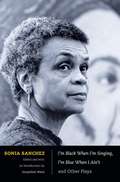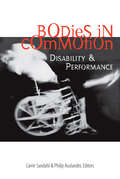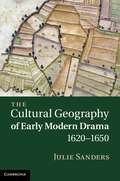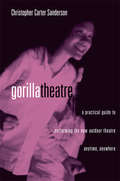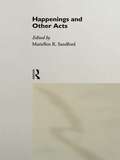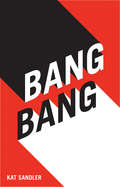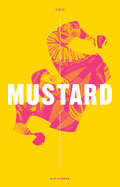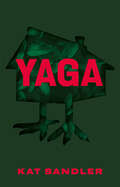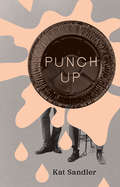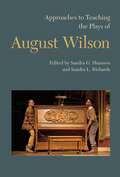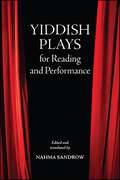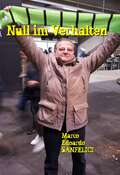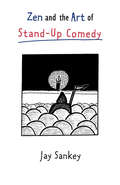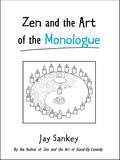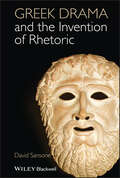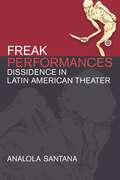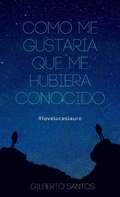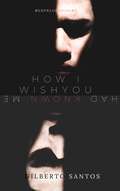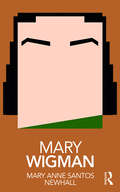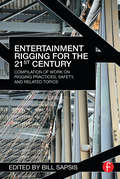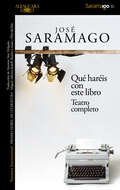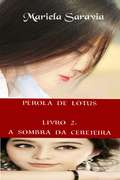- Table View
- List View
I'm Black When I'm Singing, I'm Blue When I Ain't: And Other Plays
by Sonia SanchezSonia Sanchez is a prolific, award-winning poet and one of the most prominent writers in the Black Arts movement. This collection brings her plays together in one volume for the first time. Like her poetry, Sanchez's plays voice her critique of the racism and sexism that she encountered as a young female writer in the black militant community in the late 1960s and early 1970s, her ongoing concern with the well-being of the black community, and her commitment to social justice. In addition to The Bronx Is Next (1968), Sister Son/ji (1969), Dirty Hearts (1971), Malcolm/Man Don't Live Here No Mo (1972), and Uh, Uh; But How Do It Free Us? (1974), this collection includes the never-before-published dramas I'm Black When I'm Singing, I'm Blue When I Ain't (1982) and 2 X 2 (2009), as well as three essays in which Sanchez reflects on her art and activism. Jacqueline Wood's introduction illuminates Sanchez's stagecraft in relation to her poetry and advocacy for social change, and the feminist dramatic voice in black revolutionary art.
Bodies in Commotion: Disability and Performance
by Carrie Sandahl Philip Auslander"A testament to the synergy of two evolving fields. From the study of staged performances to examinations of the performing body in everyday life, this book demonstrates the enormous profitability of moving beyond disability as metaphor. . . . It's a lesson that many of our cultural institutions desperately need to learn. " -Martin F. Norden, University of Massachusetts-Amherst This groundbreaking collection imagines disabled bodies as "bodies in commotion"-bodies that dance across artistic and discursive boundaries, challenging our understanding of both disability and performance. In the book's essays, leading critics and artists explore topics that range from theater and dance to multi-media performance art, agit-prop, American Sign Language theater, and wheelchair sports. Bodies in Commotionis the first collection to consider the mutually interpretive qualities of these two emerging fields, producing a dynamic new resource for artists, activists, and scholars.
Ibsen’s Houses
by Mark B. SandbergHenrik Ibsen's plays came at a pivotal moment in late nineteenth-century European modernity. They engaged his public through a strategic use of metaphors of house and home, which resonated with experiences of displacement, philosophical homelessness, and exile. The most famous of these metaphors - embodied by the titles of his plays A Doll's House, Pillars of Society, and The Master Builder - have entered into mainstream Western thought in ways that mask the full force of the reversals Ibsen performed on notions of architectural space. Analyzing literary and performance-related reception materials from Ibsen's lifetime, Mark B. Sandberg concentrates on the interior dramas of the playwright's prose-play cycle, drawing also on his selected poems. Sandberg's close readings of texts and cultural commentary present the immediate context of the plays, provide new perspectives on them for international readers, and reveal how Ibsen became a master of the modern uncanny.
The Cultural Geography of Early Modern Drama, 1620–1650
by Julie SandersLiterary geographies is an exciting new area of interdisciplinary research. Innovative and engaging, this book applies theories of landscape, space and place from the discipline of cultural geography within an early modern historical context. Different kinds of drama and performance are analysed: from commercial drama by key playwrights to household masques and entertainment performed by families and in semi-official contexts. Sanders provides a fresh look at works from the careers of Ben Jonson, John Milton and Richard Brome, paying attention to geographical spaces and habitats like forests, coastlines and arctic landscapes of ice and snow, as well as the more familiar locales of early modern country estates and city streets and spaces. Overall, the book encourages readers to think about geography as kinetic, embodied and physical, not least in its literary configurations, presenting a key contribution to early modern scholarship.
Early Modern Drama, 1576-1642
by Julie SandersEngaging and stimulating, this Introduction provides a fresh vista of the early modern theatrical landscape. Chapters are arranged according to key genres (tragedy, revenge, satire, history play, pastoral and city comedy), punctuated by a series of focused case studies on topics ranging from repertoire to performance style, political events to the physical body of the actor, and from plays in print to the space of the playhouse. Julie Sanders encourages readers to engage with particular dramatic moments, such as opening scenes, skulls on stage or the conventions of disguise, and to apply the materials and methods contained in the book in inventive ways. A timeline and frequent cross-references provide continuity. Always alert to the possibilities of performance, Sanders reveals the remarkable story of early modern drama not through individual writers, but through repertoires and company practices, helping to relocate and re-imagine canonical plays and playwrights.
Gorilla Theater: A Practical Guide to Performing the New Outdoor Theater Anytime, Anywhere
by Christopher Carter SandersonFirst Published in 2003. Routledge is an imprint of Taylor & Francis, an informa company.
Happenings and Other Acts (Worlds of Performance)
by Mariellen R. SandfordFirst published in 2004. Routledge is an imprint of Taylor & Francis, an informa company.
BANG BANG
by Kat SandlerLila, a young Black ex-cop, has been on leave from the police force ever since she shot an unarmed Black youth. She’s moved back in with her mother, Karen, and is drinking beer for breakfast. So when Tim, a white playwright, shows up at her door to casually inform her that his play inspired by her experience is being adapted into a movie, Lila’s trauma is dragged out for speculation once again. The star of the film, their ex-cop bodyguard and Karen are pulled into the fight, leading to an epic metatheatrical standoff in a living room play about a living room play about gun violence, police, art and appropriation. This dark, fast-paced dramedy by the author of Punch Up and Mustard traces the responsibility we have as artists in storytelling and the impact of what it means to be inspired by true events.
Mustard
by Kat SandlerMustard shouldn’t still be here, but he is. Imaginary friends don’t normally stay with their Person until that Person is a troubled teenager, exhibiting strangely violent behaviour. Imaginary friends don’t suddenly become visible to their Person’s mom and then go on a date with them, either. But Mustard is special. At least that’s what he thinks. And he’s not ready to leave his best friend, Thai, even though he’s in deep trouble with some unsavoury characters who are ready to enforce some serious rules. And, oh yeah, he’s falling in love with Sadie, Thai’s recently separated, wine-guzzling mom, who doesn’t believe he’s real. A twisted fairy tale about friendship, love, growing up, moving on and finding magic where you least expect it, this darkly comedic bedtime story by Canadian theatre’s indie darling blurs imagination with reality in order to save a family from its own destruction.
Yaga
by Kat SandlerYaga is a mash-up of police procedural, noir thriller, comedy, and lore.Kat wanted to point out how society speaks of and labels women, especially older women.
Punch Up
by Kat Sandler SandlerDuncan has always been a pretty boring guy, leading a simple life while working at a bread factory. Then he stumbles upon Brenda, a sad young woman who’s about to end her life. Convinced he’s fallen in love, Duncan strikes up a desperate deal: if he can get her to laugh, she'll give life another shot, but if she doesn’t even giggle, he'll help her go through with her plan. There’s just one catch: Duncan isn’t funny. At all. So he borrows Pat, his second-favourite comedian, to help him come up with the perfect routine. But Pat is having a hard time mustering his sense of humour after a bad break-up, and the last thing he wants to do is teach a lonely loser the difference between knock-knock jokes and schadenfreude while chained to a typewriter. A tragicomedy of three misfits, Punch Up navigates a hostage situation and a life-or-death comedy lesson to show just how far we’ll go for a laugh.
Approaches to Teaching the Plays of August Wilson (Approaches to Teaching World Literature #140)
by Sandra G. Shannon and Sandra L. RichardsThe award-winning playwright August Wilson used drama as a medium to write a history of twentieth-century America through the perspectives of its black citizenry. In the plays of his Pittsburgh Cycle, including the Pulitzer Prize-winning Fences and The Piano Lesson, Wilson mixes African spirituality with the realism of the American theater and puts African American storytelling and performance practices in dialogue with canonical writers like Aristotle and Shakespeare. As they portray black Americans living through migration, industrialization, and war, Wilson's plays explore the relation between a unified black consciousness and America's collective identity.In part 1 of this volume, "Materials," the editors survey sources on Wilson's biography, teachable texts of Wilson's plays, useful secondary readings, and compelling audiovisual and Web resources. The essays in part 2, "Approaches," look at a diverse set of issues in Wilson's work, including the importance of blues and jazz, intertextual connections to other playwrights, race in performance, Yoruban spirituality, and the role of women in the plays.
Yiddish Plays for Reading and Performance (SUNY series in Contemporary Jewish Literature and Culture)
by Nahma SandrowYiddish theater was first and foremost fine theater, with varied repertory and actors of high quality. The three stage-ready plays and nine individual scenes collected here, most of them well-known in Yiddish repertory but never before translated, offer an introduction to the full range of Yiddish theater. Fresh, lively, and accurate, these translations have been prepared for reading or performance by award-winning playwright and scholar Nahma Sandrow. They come with useful stage directions, notes, and playing histories, as well as comments by directors who have worked in both English and Yiddish theater. In the three full-length plays, a matriarch battles for control of her business and her family (Mirele Efros; or, The Jewish Queen Lear); two desperate women struggle over a man, who himself is struggling to change his life (Yankl the Blacksmith); and, in a charming fantasy village, a poetic village fiddler gambles on romance (Yoshke the Musician). The nine scenes from selected other plays are shaped to stand alone and range in genre from symbolist to naturalist, operetta to vaudeville, domestic to romantic to avant-garde. In her preface, Sandrow contextualizes the plays in modern Western theater history from the nineteenth century to the present. Yiddish Plays for Reading and Performance is not nostalgia—just a collection of good plays that also serves as an informed introduction to Yiddish theater at its liveliest.
Null im Verhalten: Die Zeugnisse von drei Jahren Juventus-Spiele.
by Marco Edoardo SanfeliciDie Zeugnisse von drei Jahren Juventus-Spiele. Null im Verhalten Das Buch sammelt die besten Zeugnisse von Marco Edoardo Sanfelici. Die Urteile, die nach jedem Juventus-Spiel Fotos von der Leistung des Juventus-Teams machen, sind Urteile ohne Berufung. Aus dem brillanten und leidenschaftlichen Geist eines Fan-Kommentators sind hier die urkomischen Bewertungen, die das Verhalten Ihrer größten Idole auf dem Platz besser als jedes VAR-Bild bezeugen.
Zen and the Art of Stand-Up Comedy (Theatre Arts Ser.)
by Jay SankeyIn this engaging and disarmingly frank book, comic Jay Sankey spills the beans, explaining not only how to write and perform stand-up comedy, but how to improve and perfect your work. Much more than a how-to manual Zen and the Art of Stand-Up Comedy is the most detailed and comprehensive book on the subject to date.
Zen and the Art of the Monologue
by Jay SankeyJay Sankey--stand-up comic, magician, and cartoonist--is back with another book for performers. Building on the success of his Zen and the Art of Stand-up Comedy, Jay is moving further into the uncharted wilds of solo performance.
Greek Drama and the Invention of Rhetoric
by David SansoneAsserts a novel and controversial theory on the origins of rhetoric that differs radically from the standard view Argues that it was the theatre of Ancient Greece, first appearing around 500 BC, that prompted the development of formalized rhetoric, which evolved soon thereafter Provides a cogent reworking of existing evidence Reveals the bias and inconsistency of Aristotle
Freak Performances: Dissidence in Latin American Theater
by Analola SantanaThe figure of the freak as perceived by the Western gaze has always been a part of the Latin American imaginary, from the letters that Columbus wrote about his encounters with dog-faced people to Shakespeare's Caliban. The freak acquires greater significance in a globalized, neoliberal world that defines the "abnormal" as one who does not conform mentally, physically, or emotionally and is unable or unwilling to follow the economic and cultural norms of the institutions in power. Freak Performances examines the continuing effects of colonialism on modern Latin American identities, with a particular focus on the way it has constructed the body of the other through performance. Theater questions the representations of these bodies, as it enables the empowerment of the silenced other; the freak as a spectacle of otherness finds in performance an opportunity for re-appropriation by artists resisting the dominant authority. Through an analysis of experimental theater, dance theater, performance art, and gallery-based installation art across eight countries, Analola Santana explores the theoretical issues shaped by the encounters and negotiations between different bodies in the current Latin American landscape.
Como me gustaría que me hubiera conocido
by Gilberto Santos¿Sería posible enamorarse de alguien que ya se fue? Lucas y Lauro nunca se conocieron, no en esta vida ... Pero lo que sólo sería un viaje de vacaciones descomprometidas en el interior de São Paulo da un giro y revive la vida de Lauro, un psicólogo siempre dispuesto a ayudar. Sus creencias se ponen a prueba en medio de acontecimientos que desafían la lógica. Después de verse envuelto en un misterioso suicidio que sacudía la pequeña ciudad de Vinhedo, su ayuda a la familia del muerto no terminaría tan pronto; y luego lauro estaría envuelto y enamorado de Lucas. Del otro lado, sin saberlo, estaría también ayudando a su alma gemela a elevarse espiritualmente. Acompañe y emociónese con esta historia, que no deja dudas de que la muerte es sólo un viaje y de que las almas gemelas realmente existen.
How I wish you had known me (DRAMA / Gay & Lesbian #1)
by Gilberto SantosIs it possible to fall in love with someone who's already gone? Lucas and Lauro never met, not in this life... But what would only be an uncompromising holiday trip in the interior of São Paulo turns around the life of Lauro, a psychologist always willing to help. His beliefs are to put to the test amid events that defy logic. After being involved in a mysterious suicide that would hit the small town of Vinhedo, his help to the dead's family would not end as expected; soon Lauro would be involved and in love with Lucas. On the other side, unknowingly, it would also be helping his soul mate to rise spiritually. Follow and be moved by this story, which leaves no doubt that death is just a journey and that soul mates really exist
Mary Wigman: Modernity And Mary Wigman, 1886--1973 (Routledge Performance Practitioners)
by Mary Anne Santos NewhallThis book considers dancer, teacher, and choreographer Mary Wigman, a leading innovator in Expressionist dance whose radical explorations of movement and dance theory are credited with expanding the scope of dance as a theatrical art. Now reissued, this book combines: a full account of Wigman’s life and work an analysis of her key ideas detailed discussion of her aesthetic theories, including the use of space as an "invisible partner" and the transcendent nature of performance a commentary on her key works, including Hexentanz and The Seven Dances of Life an extensive collection of practical exercises designed to provide an understanding of Wigman’s choreographic principles and her uniquely immersive approach to dance. As a first step towards critical understanding, and as an initial exploration before going on to further, primary research, Routledge Performance Practitioners are unbeatable value for today’s student.
Entertainment Rigging for the 21st Century: Compilation of Work on Rigging Practices, Safety, and Related Topics
by Bill SapsisFrom the basics of physical forces and mathematical formulas to performer flying and stage automation, Entertainment Rigging for the 21st Century provides you with insider information into rigging systems and the skills you need to safely operate them. Over the past decade, the entertainment industry has witnessed major changes in rigging technology, as manually operated rigging has given way to motorized systems in both permanent and touring productions, and greater attention has been paid to standardizing safety practices. This book leads you through what is currently happening in the industry, why it’s happening, and how. Accessible for riggers and non-riggers alike, it contains details on the technology and methodology used to achieve the startling effects found in concerts and stage shows. With a foreword written by Monona Rossol, this text contains contributions from industry leaders including: Rocky Paulson Bill Gorlin Tray Allen Roy Bickel Keith Bohn Karen Butler Stuart Cox Bill Sapsis Dan Culhane Eddie Raymond Chris Higgs Carla Richters Joe McGeough Scott Fisher
Qué haréis con este libro
by José SaramagoToda la obra dramática del Premio Nobel de Literatura portugués reunida en un solo volumen por primera vez en español: una perfecta combinación de ideas plenamente vigentes y maestría literaria. «La memoria es el dramaturgo que todos tenemos dentro. Pone en escena e inventa un disfraz para cada ser vinculado con nosotros. La distancia entre lo que fue una persona y lo que se recuerda de ella es literatura.»José Saramago José Saramago se llamaba a sí mismo «el dramaturgo involuntario» porque siempre sintió que su contribución a ese género venía marcada por circunstancias azarosas. Pero incluso así, su genio creativo dio luz a las cinco obras teatrales que se reúnen ahora en este volumen: La noche (1979), ¿Qué haré con este libro? (1980), La segunda vida de Francisco de Asís (1987), In Nomine Dei (1993) y Don Giovanni o El disoluto absuelto (2005). Salvo La noche e In Nomine Dei, se publican por primera vez en castellano. Con la hondura propia de toda su obra -aunque revestida de una aparente simplicidad-, brilla en estas piezas magistrales la ironía del autor y la agudeza de sus reflexiones. Los grandes héroes dejan paso a los hombres y mujeres sencillos que, desde la honestidad y la firmeza de sus convicciones, luchan por la libertad, la justicia y un futuro mejor. Ambientadas en lugares y épocas distintos que van desde el Portugal del triunfo de la revolución de los Claveles o el renacentista del poeta Camões, a la Alemania de la reforma luterana, la Italia de don Giovanni o la intemporalidad deslocalizada de una empresa en crecimiento, en ellas las grandes cuestiones que caracterizan el pensamiento del autor están expuestas sin enjuiciamientos ni sentencias. Todas ellas son parte de un diálogo que Saramago mantiene para siempre, desde cada una de las páginas que escribió, con sus lectores.
Qué haréis con este libro: Teatro completo
by José SaramagoToda la obra dramática del Premio Nobel de Literatura portugués reunida en un solo volumen por primera vez en español: una perfecta combinación de ideas plenamente vigentes y maestría literaria. «La memoria es el dramaturgo que todos tenemos dentro. Pone en escena e inventa un disfraz para cada ser vinculado con nosotros. La distancia entre lo que fue una persona y lo que se recuerda de ella es literatura.»José Saramago José Saramago se llamaba a sí mismo «el dramaturgo involuntario» porque siempre sintió que su contribución a ese género venía marcada por circunstancias azarosas. Pero incluso así, su genio creativo dio luz a las cinco obras teatrales que se reúnen ahora en este volumen: La noche (1979), ¿Qué haré con este libro? (1980), La segunda vida de Francisco de Asís (1987), In Nomine Dei (1993) y Don Giovanni o El disoluto absuelto (2005). Salvo La noche e In Nomine Dei, se publican por primera vez en castellano. Con la hondura propia de toda su obra -aunque revestida de una aparente simplicidad-, brilla en estas piezas magistrales la ironía del autor y la agudeza de sus reflexiones. Los grandes héroes dejan paso a los hombres y mujeres sencillos que, desde la honestidad y la firmeza de sus convicciones, luchan por la libertad, la justicia y un futuro mejor. Ambientadas en lugares y épocas distintos que van desde el Portugal del triunfo de la revolución de los Claveles o el renacentista del poeta Camões, a la Alemania de la reforma luterana, la Italia de don Giovanni o la intemporalidad deslocalizada de una empresa en crecimiento, en ellas las grandes cuestiones que caracterizan el pensamiento del autor están expuestas sin enjuiciamientos ni sentencias. Todas ellas son parte de un diálogo que Saramago mantiene para siempre, desde cada una de las páginas que escribió, con suslectores.
Pérola de Lótus - livro 2: a sombra da cerejeira
by Mariela Saravia Ana Paula Ruth LimaCom a morte de Donovan, Kiele deixe de se sentir parte de Londres e de Adolf, aquele homem que tanto ama, pois seu sangue inglês foi à maldição de seu povo. Trabalha em diferentes ofícios, até que chega a uma família londrina estabelecida na China e se transforma na instrutora da filha de um poderoso empresário. Rubén Mosses é um homem de poder, que procura a forma de fazê-la sua amante, mas quando Kiele está disposta da lhe dar uma relação extra-matrimonial, estoura a Segunda Guerra do Ópio, que a obriga se separar daquela família que a acolheu por seis anos e, sobretudo, da menina Catarina que nessa época já era uma jovem de quinze anos. Diante da noticia de que a China se encontra em Guerra de novo, Adolf McColl realiza a viajem para China que estava adiando, agora não em busca de tecidos para seu império, mas sim para proteger a única mulher que amou e segue amando. Mas, as visões da morte não o deixam em paz, e a dúvida de não saber se Kiele está viva ou morta, lhe torturam até o cansaço.
